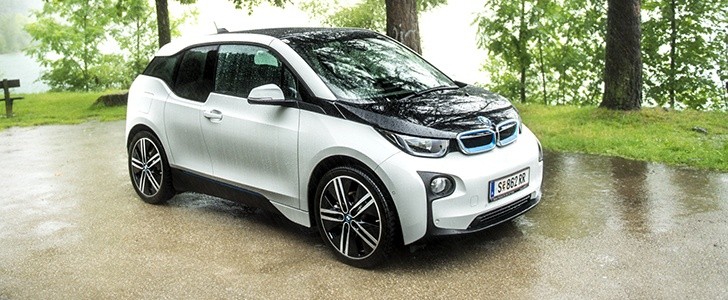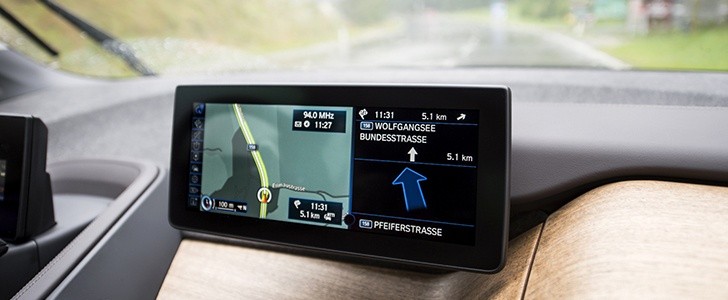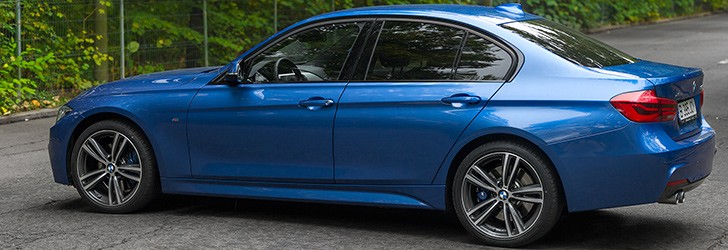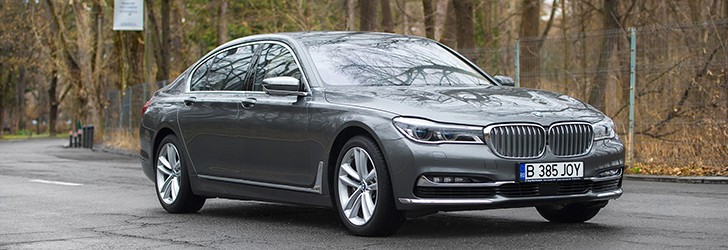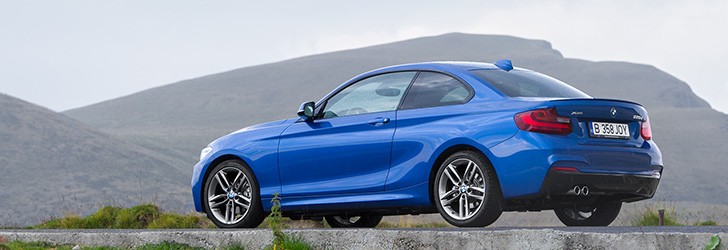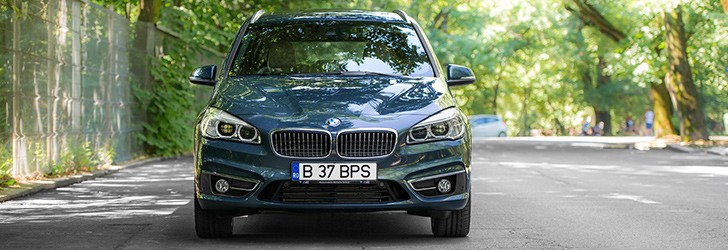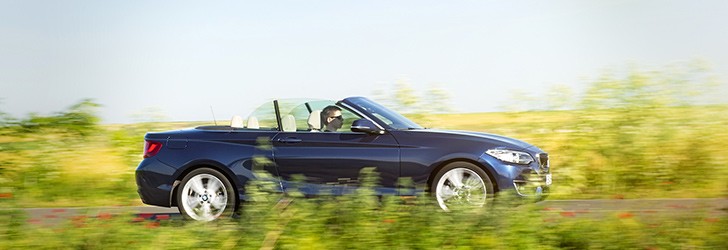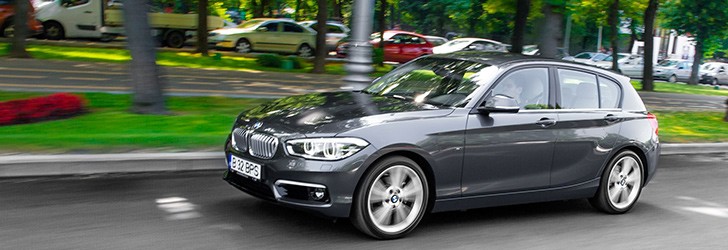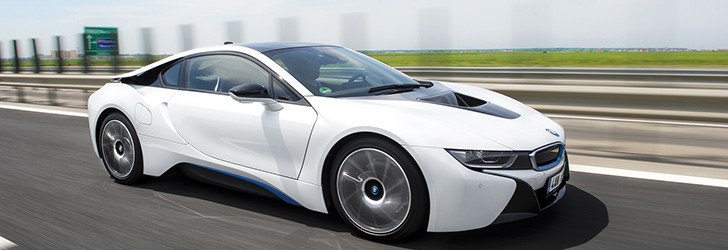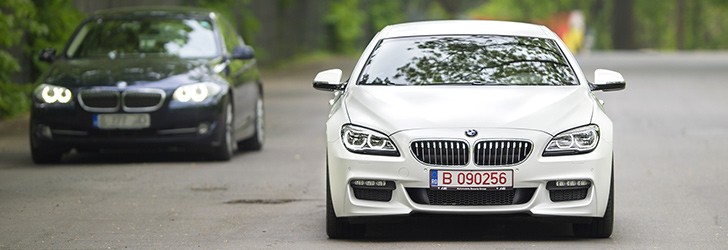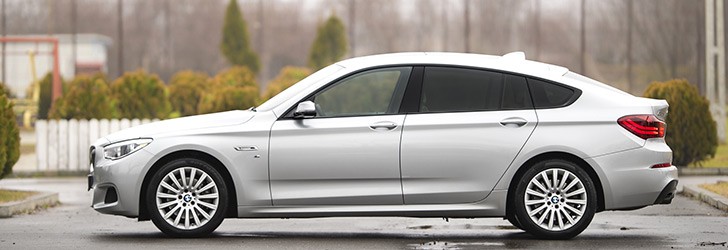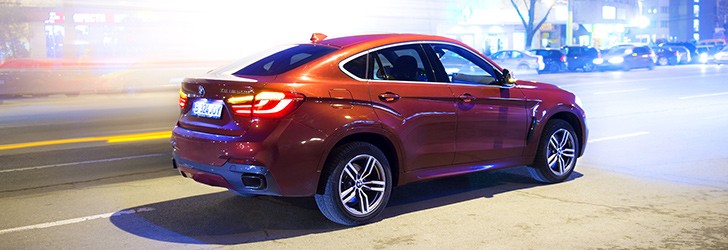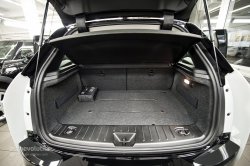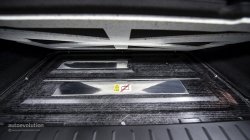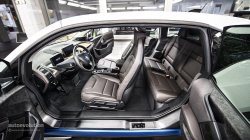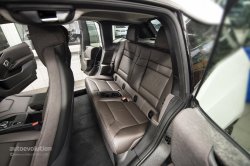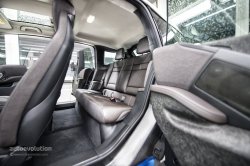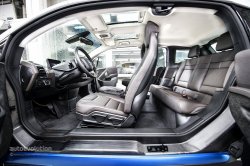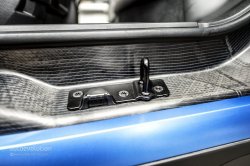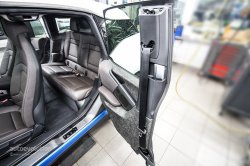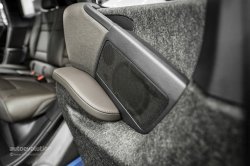BMW i3 Review
OUR TEST CAR: 2014 BMW i3
These driving modes are important not because they quench our thirst for buttons, but due to their positive effect on the driving range. The i3 feeds itself off a 21.6 kWh lithium-ion battery pack, whose usable capacity is 18.8 kWh – the difference is there to keep the battery from being completely depleted, as that can cause permanent damage. According to the EPA ratings show, will give you an autonomy of 81 miles (130 km).
With a full charge and a moderate driving style, you'll get up to 78 miles (125 km), while each of the "Eco Pro" modes adds between 6 and 9 miles (10-15 km). We used a mix between "Comfort" and "Eco Pro" and managed about 60 miles (100 km). The difference resides in our intimate moments with the throttle. In terms of electric consumption, we averaged 17.4 kWh, while a more moderate drive brought the value to 15.5 kWh.
As for the charging part, if you're in a hurry, 80 percent of the juice is available in 30 minutes, providing the i3 is pluggeg in a fast-charging station (50 kW). We are talking about DC charging here. When it comes to the rest of the charging times, a standard AC household outlet (2.4kW, 10A) means the i3 needs 8 hours for a full charge. Then there are the AC fast-charging solutions (7.4 kW, 32 A), such as the one offered by the BMW i Wallbox, which reduces the time to 3.5 hours.
We're no experts, but we do have to warn you about cold weather driving. Even with BMW's work on the i3, you could expect a drop in battery capacity, depending on how low the thermometer decides to go in the winter. Without proper air-conditioning for the electric hardware (the i3 has this), the loss can climb up to 20 or 30 percent.
All this battery talk reminds us of a little chat we had with a charismatic Asian guy prior to driving the i3.
It appears that while the Japanese required the full details of the i3, in order to bring a bespoke application of the system, the Germans refused, deciding to take care of the implementation themselves.
Oh and the man also said he liked roasted watermelons. We didn't quite care about that though.
If you're the kind that struggles with parking, you'll enjoy the fully automated feature offered by the i3. This is one of the most advanced we've tested, as you don't need to lift one finger. In fact, what you have to do is keep the "P" button pressed, while the i3 does its stuff. This is one fancy system - not only does it parallel park the car, but it also moves closer to the car in front once the maneuver is over, making sure your i3 is tucked in neatly.
This isn't the only smart feature on this BMW. For instance, you can have the optional Driving Assistant Plus, whose Collision Warning sidekick can prime the brakes if necessary during city driving. This also includes Active Cruise Control that can autonomously bring the car to a halt and back on the move again. Mind you, the system does not handle the steering. That is the job of the Traffic Jam Assist, which takes care of it when the traffic becomes clogged or on the highway.
While we were going though the toys BMW has fitted on the i3, we passed the urban borders. It doesn't take too long to notice that while the i3 is suitable for open road trips, it does have its limits.
The i3 does deserve its premium aura and, out here on the open road, this means the car makes you feel safe. This happens up to about 60-75 mph (100-120 km/h). By the way, you shouldn't take the car past this level anyway and there are multiple clues for that.
For instance, the official acceleration figures don't tell the whole story and we're referring to the 4.9 seconds for the mph (80 to 120 km/h) sprint. In real life, the i3 feels like it has two gears, not just one. The zippy feeling you get up to 100 km/h turns into a more tempered acceleration between this value and the 93 mph (150 km/h) top speed.
Another clue that you should stick to the speed limits is that you will loose confidence in the otherwise decent brakes. The aforementioned limit is what you need in order to enjoy the i3 when commuting, for example.
We've been driving BMW's electric vehicle in a moderate fashion for the last hour or so and the result is a cozy experience - the i3 is easy to drive and keeps your passenger(s) relaxed.
As far as the handling is concerned, the i3 has a perfect balance at city speeds. Once you step outside urban roads though you will notice the body roll. Despite the RWD layout, the setup is biased towards the safer understeer. If you are foolish and mix the full instant electric torque with a wet, tight-radius corner, you can turn this into oversteer though. We were silly enough to play this game, but, after a limited slip angle, the electronic nannies stepped in, catching the slide in a sure-footed manner.
We'll use this occasion to mention that while you can put the DSC (Dynamic Stability Control) in the looser DTC (Dynamic Traction Control) mode, you can't diable the DSC like on the conventional Bimmers. Regarding the electronic brain here, you can think of it as your fiancée’s ex-military father, who seems tough but is actually a nice bloke once you get to know him.
Interestingly enough, while the skinny tires do let go earlier, their nature also means the car is more eager to communicate its intentions to its driver. We'll remind you that the Toyota GT 86 uses Prius tires instead of the usual sport rubber, in order to allow the one behind the wheel to dance about when he or she desires so.
While the slow city speeds didn't allow the coasting function to play its part, this can be used out here on the B-roads. You'll need some time to get used to the neutral point of the throttle, but the indications on the dash will help.
In a similar fashion, the dash will instruct you when to step off the gas based on the navigation system's indications - for instance, the i3 knows when there's a village approaching and prompts you early so that you can make full use of your momentum and maximize your range.
All these eco fun and games are the car's way of connecting to you and you know what? It's great. These things should be taught in driving schools all over the world.
Speaking about autonomy, it's time to mention one of the most important parts of the i language: Rex. No, not the Tyrannosaurus, we're referring to the range extender here.
Serving this as an option, BMW borrowed a 675cc 34 hp two-cylinder petrol engine from its Motorrad division for the i3. Don't get your leather jacket out yet, the unit doesn't power the wheels, but acts as a generator, feeding the battery pack. This starts operating when the batter drops below 20 percent or when you ask it to via a dedicated mode.
The range extender doesn't take away any cabin space, as the engine sits next to the electric one, while the fuel tank is located in the front side of the vehicle.
With a capacity of 9 liters (2.4 gallons), this promises an extra range of about 60 miles (100 km). This is the first clue that the range extender is something you should do without – 26 mpg (9 liters per 100 km), doesn't sound all that efficient.
We mustn't forget the extra lbs (150 kg) of the Rex, which bring the 0 to 62 mph time to 7.9 seconds (+0.7 seconds). The extra weight also affects the electric efficiency of the i3. For instance, the official electric range drops to 70 miles (106 km). Besides, the i3 Rex is not even all that electric to run anymore, since it has a petrol engine in it.
Oh and the aforementioned ups and downs are true for Europe. In the US, legislation has forced BMW to reduce the fuel tank's capacity to 1.9 gallons (7.2 liters), so you also get less extra range. Despite BMW working on the legal side, there may still be scenarios or states where the range extender may deprive you of certain EV-only driving rights.
In fact, BMW itself recommends that you buy the i3 without the range extender. It is also BMW that offers the i3 with a whole range of mobility services. One of these is of particular interest here, as it caters to the i3 buyers' long distance traveling needs. If you buy one of these EVs, BMW can supply you with one of its normal cars for journeys outside the city. While the offer is welcome, it does have its limitations. For example, there is obviously a schedule that needs to be set up ahead of the desired drive.
Since we're talking recommendations, we must mention what the Euro NCAP had to say about the i3. The BMW received a four out of five rating, being left behind by cars like the Nissan LEAF, Renault ZOE, Chevrolet Volt or Toyota Prius.
The CFRP on aluminum structure of the car behaved well in the front and side impact test - even the more demanding side pole impact didn't manage to disturb the battery pack, for example. Alas, the vehicle didn't provide proper protection for the driver's left leg or against rear crash-caused whiplash injuries. The i3 may be friendly to nature, but the same can't be said about pedestrians, offering poor protection in this area.
While the i3 is more or less limited to city use as a result of its driving range, it's best to drive it between the urban borders, as this is where the car shines. As far as city driving goes, the i3 scores ten out of ten in our charts.
BMW has made sustained efforts to package the i3 as a premium product and this shows. For instance, while the car's specs have nothing to do with Tesla's all-electric sports sedan, the Model S, the BMW feels more elaborate.
The overall setup of the car, such as the suspensions or the brakes, were also tailored for urban use, so while the i3 can sustain open road trips, it won't excel in that area. But perhaps the worst part about the car is its four-star Euro NCAP rating.
The i3 deserves its roundels thanks to the fact that, in its quest for electric propulsion, it has a strong personality. This is definitely not the kind of experience you forget - the car keeps the one behind the wheel connected in an eco fashion rather than depriving him of the driving experience.
As for the idea of paying at least US$ 41,350 or EUR 34,950 for a city car, this is another discussion. As for the Rex, you should add US$ 3,850 or EUR 4,500. And we can't go over this without mention its rivals. The closest one comes, in the traditional fashion, from Mercedes. Unlike the i3 though, the B-Class Electric Drive is a model that's been converted to run on battery power, which means it doesn't have the same impact. On the other hand, its price is similar to that of the BMW, while its official driving range is slightly greater at 85 miles (136 km).
Of course, you could always climb higher up the specs ladder to the 60 kWh entry-level Tesla Model S. Nevertheless, that also comes with a US$ 30,000 financial drawback, so it's not like it shares customers with the i3.
Should you skip the premium ambitions, you can move to a Nissan LEAF, which offer the same range as the i3, but with more cabin space and a US$ 15,000 advantage in the pricing area.
Since we're skipping stuff, we can also talk about ditching the electric stuff altogether and going for a Prius Plug-In Hybrid. Once again in the non-premium arena, the Prius Plug-In has a MSRP of US$ 29,990, offering a more complete package.
The BMW i3 turns out to be a very important member of the electric car genre. It also stands for BMW transforming its own ways and the manner in which it connects with its customers.
This is why we look to the future, when we expect the current limitations of battery technology to be overcome and thus allow for a more viable electric vehicle market. We believe the most versatile green propulsion solution nowadays resides within plug-in hybrids - BMW is currently working on such models, which will use the i3's electric motor to assist their internal combustion engines (ICE).
The current EV shortcomings obviously won't solve themselves. While BMW has experimented with hydrogen-powered ICEs in the past, the carmaker now believes hydrogen fuel cell tech is the solution for long-range electric driving. Fuel cell development is an important reason for which BMW has joined forces with Toyota, which is almost ready to launch a production vehicle using such hardware.
In a few years from now, we could see an i3 incorporating hydrogen fuel cell technology. This means the car will move from a city vehicle, or a fetish of the early adopters, to a complete proposal.
As for the charging part, if you're in a hurry, 80 percent of the juice is available in 30 minutes, providing the i3 is pluggeg in a fast-charging station (50 kW). We are talking about DC charging here. When it comes to the rest of the charging times, a standard AC household outlet (2.4kW, 10A) means the i3 needs 8 hours for a full charge. Then there are the AC fast-charging solutions (7.4 kW, 32 A), such as the one offered by the BMW i Wallbox, which reduces the time to 3.5 hours.
We're no experts, but we do have to warn you about cold weather driving. Even with BMW's work on the i3, you could expect a drop in battery capacity, depending on how low the thermometer decides to go in the winter. Without proper air-conditioning for the electric hardware (the i3 has this), the loss can climb up to 20 or 30 percent.
All this battery talk reminds us of a little chat we had with a charismatic Asian guy prior to driving the i3.
Among others, the insider whispered that the electric propulsion tech in the i3 comes from Toyota.
It appears that while the Japanese required the full details of the i3, in order to bring a bespoke application of the system, the Germans refused, deciding to take care of the implementation themselves.
Oh and the man also said he liked roasted watermelons. We didn't quite care about that though.
If you're the kind that struggles with parking, you'll enjoy the fully automated feature offered by the i3. This is one of the most advanced we've tested, as you don't need to lift one finger. In fact, what you have to do is keep the "P" button pressed, while the i3 does its stuff. This is one fancy system - not only does it parallel park the car, but it also moves closer to the car in front once the maneuver is over, making sure your i3 is tucked in neatly.
This isn't the only smart feature on this BMW. For instance, you can have the optional Driving Assistant Plus, whose Collision Warning sidekick can prime the brakes if necessary during city driving. This also includes Active Cruise Control that can autonomously bring the car to a halt and back on the move again. Mind you, the system does not handle the steering. That is the job of the Traffic Jam Assist, which takes care of it when the traffic becomes clogged or on the highway.
While we were going though the toys BMW has fitted on the i3, we passed the urban borders. It doesn't take too long to notice that while the i3 is suitable for open road trips, it does have its limits.
The i3 does deserve its premium aura and, out here on the open road, this means the car makes you feel safe. This happens up to about 60-75 mph (100-120 km/h). By the way, you shouldn't take the car past this level anyway and there are multiple clues for that.
For instance, the official acceleration figures don't tell the whole story and we're referring to the 4.9 seconds for the mph (80 to 120 km/h) sprint. In real life, the i3 feels like it has two gears, not just one. The zippy feeling you get up to 100 km/h turns into a more tempered acceleration between this value and the 93 mph (150 km/h) top speed.
Another clue that you should stick to the speed limits is that you will loose confidence in the otherwise decent brakes. The aforementioned limit is what you need in order to enjoy the i3 when commuting, for example.
We've been driving BMW's electric vehicle in a moderate fashion for the last hour or so and the result is a cozy experience - the i3 is easy to drive and keeps your passenger(s) relaxed.
As far as the handling is concerned, the i3 has a perfect balance at city speeds. Once you step outside urban roads though you will notice the body roll. Despite the RWD layout, the setup is biased towards the safer understeer. If you are foolish and mix the full instant electric torque with a wet, tight-radius corner, you can turn this into oversteer though. We were silly enough to play this game, but, after a limited slip angle, the electronic nannies stepped in, catching the slide in a sure-footed manner.
We'll use this occasion to mention that while you can put the DSC (Dynamic Stability Control) in the looser DTC (Dynamic Traction Control) mode, you can't diable the DSC like on the conventional Bimmers. Regarding the electronic brain here, you can think of it as your fiancée’s ex-military father, who seems tough but is actually a nice bloke once you get to know him.
Interestingly enough, while the skinny tires do let go earlier, their nature also means the car is more eager to communicate its intentions to its driver. We'll remind you that the Toyota GT 86 uses Prius tires instead of the usual sport rubber, in order to allow the one behind the wheel to dance about when he or she desires so.
While the slow city speeds didn't allow the coasting function to play its part, this can be used out here on the B-roads. You'll need some time to get used to the neutral point of the throttle, but the indications on the dash will help.
In a similar fashion, the dash will instruct you when to step off the gas based on the navigation system's indications - for instance, the i3 knows when there's a village approaching and prompts you early so that you can make full use of your momentum and maximize your range.
All these eco fun and games are the car's way of connecting to you and you know what? It's great. These things should be taught in driving schools all over the world.
Speaking about autonomy, it's time to mention one of the most important parts of the i language: Rex. No, not the Tyrannosaurus, we're referring to the range extender here.
Serving this as an option, BMW borrowed a 675cc 34 hp two-cylinder petrol engine from its Motorrad division for the i3. Don't get your leather jacket out yet, the unit doesn't power the wheels, but acts as a generator, feeding the battery pack. This starts operating when the batter drops below 20 percent or when you ask it to via a dedicated mode.
The range extender doesn't take away any cabin space, as the engine sits next to the electric one, while the fuel tank is located in the front side of the vehicle.
With a capacity of 9 liters (2.4 gallons), this promises an extra range of about 60 miles (100 km). This is the first clue that the range extender is something you should do without – 26 mpg (9 liters per 100 km), doesn't sound all that efficient.
We mustn't forget the extra lbs (150 kg) of the Rex, which bring the 0 to 62 mph time to 7.9 seconds (+0.7 seconds). The extra weight also affects the electric efficiency of the i3. For instance, the official electric range drops to 70 miles (106 km). Besides, the i3 Rex is not even all that electric to run anymore, since it has a petrol engine in it.
The Rex remains an option for those who must drive an i3 and can't do so otherwise.
Oh and the aforementioned ups and downs are true for Europe. In the US, legislation has forced BMW to reduce the fuel tank's capacity to 1.9 gallons (7.2 liters), so you also get less extra range. Despite BMW working on the legal side, there may still be scenarios or states where the range extender may deprive you of certain EV-only driving rights.
In fact, BMW itself recommends that you buy the i3 without the range extender. It is also BMW that offers the i3 with a whole range of mobility services. One of these is of particular interest here, as it caters to the i3 buyers' long distance traveling needs. If you buy one of these EVs, BMW can supply you with one of its normal cars for journeys outside the city. While the offer is welcome, it does have its limitations. For example, there is obviously a schedule that needs to be set up ahead of the desired drive.
Since we're talking recommendations, we must mention what the Euro NCAP had to say about the i3. The BMW received a four out of five rating, being left behind by cars like the Nissan LEAF, Renault ZOE, Chevrolet Volt or Toyota Prius.
The CFRP on aluminum structure of the car behaved well in the front and side impact test - even the more demanding side pole impact didn't manage to disturb the battery pack, for example. Alas, the vehicle didn't provide proper protection for the driver's left leg or against rear crash-caused whiplash injuries. The i3 may be friendly to nature, but the same can't be said about pedestrians, offering poor protection in this area.
While the i3 is more or less limited to city use as a result of its driving range, it's best to drive it between the urban borders, as this is where the car shines. As far as city driving goes, the i3 scores ten out of ten in our charts.
BMW has made sustained efforts to package the i3 as a premium product and this shows. For instance, while the car's specs have nothing to do with Tesla's all-electric sports sedan, the Model S, the BMW feels more elaborate.
The overall setup of the car, such as the suspensions or the brakes, were also tailored for urban use, so while the i3 can sustain open road trips, it won't excel in that area. But perhaps the worst part about the car is its four-star Euro NCAP rating.
So is it a proper BMW? Yes, but in a different manner than you'd expect.
The i3 deserves its roundels thanks to the fact that, in its quest for electric propulsion, it has a strong personality. This is definitely not the kind of experience you forget - the car keeps the one behind the wheel connected in an eco fashion rather than depriving him of the driving experience.
As for the idea of paying at least US$ 41,350 or EUR 34,950 for a city car, this is another discussion. As for the Rex, you should add US$ 3,850 or EUR 4,500. And we can't go over this without mention its rivals. The closest one comes, in the traditional fashion, from Mercedes. Unlike the i3 though, the B-Class Electric Drive is a model that's been converted to run on battery power, which means it doesn't have the same impact. On the other hand, its price is similar to that of the BMW, while its official driving range is slightly greater at 85 miles (136 km).
Of course, you could always climb higher up the specs ladder to the 60 kWh entry-level Tesla Model S. Nevertheless, that also comes with a US$ 30,000 financial drawback, so it's not like it shares customers with the i3.
Should you skip the premium ambitions, you can move to a Nissan LEAF, which offer the same range as the i3, but with more cabin space and a US$ 15,000 advantage in the pricing area.
Since we're skipping stuff, we can also talk about ditching the electric stuff altogether and going for a Prius Plug-In Hybrid. Once again in the non-premium arena, the Prius Plug-In has a MSRP of US$ 29,990, offering a more complete package.
The BMW i3 turns out to be a very important member of the electric car genre. It also stands for BMW transforming its own ways and the manner in which it connects with its customers.
This is why we look to the future, when we expect the current limitations of battery technology to be overcome and thus allow for a more viable electric vehicle market. We believe the most versatile green propulsion solution nowadays resides within plug-in hybrids - BMW is currently working on such models, which will use the i3's electric motor to assist their internal combustion engines (ICE).
The current EV shortcomings obviously won't solve themselves. While BMW has experimented with hydrogen-powered ICEs in the past, the carmaker now believes hydrogen fuel cell tech is the solution for long-range electric driving. Fuel cell development is an important reason for which BMW has joined forces with Toyota, which is almost ready to launch a production vehicle using such hardware.
In a few years from now, we could see an i3 incorporating hydrogen fuel cell technology. This means the car will move from a city vehicle, or a fetish of the early adopters, to a complete proposal.
THE END
12
Our BMW Testdrives:
Photo gallery (81)
